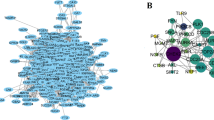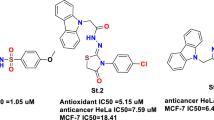Abstract
Background
The numbers of topoisomerase I targeted drugs on the market are very limited although they are used clinically for treatment of solid tumors. Hence, studies about finding new chemical structures which specifically target topoisomerase I are still remarkable.
Objectives
In this present study, we tested previously synthesized 3,4-dihydro-2H-1,4-benzoxazin-3-one derivatives to reveal their human DNA topoisomerase I inhibitory potentials.
Methods
We investigated inhibitory activities of 3,4-dihydro-2H-1,4-benzoxazin-3-one derivatives on human topoisomerase I by relaxation assay to clarify inhibition mechanisms of effective derivatives with EMSA and T4 DNA ligase based intercalation assay. With SAR study, it was tried to find out effective groups in the ring system.
Results
While 10 compounds showed catalytic inhibitory activity, 8 compounds were found to be potential topoisomerase poisons. 4 of them also exhibited both activities. 2-hydroxy-3,4-dihydro-2H-1,4-benzoxazin-3-one (BONC-001) was the most effective catalytic inhibitor (IC50:8.34 mM) and ethyl 6-chloro-4-methyl-3-oxo-3,4-dihydro-2H-1,4-benzoxazin-2-acetate (BONC-013) was the strongest potential poison (IC50:0.0006 mM). BONC-013 was much more poisonous than camptothecin (IC50:0.034 mM). Intercalation assay showed that BONC-013 was not an intercalator and BONC-001 most probably prevented enzyme-substrate binding in an unknown way. Another important result of this study was that OH group instead of ethoxycarbonylmethyl group at R position of benzoxazine ring was important for hTopo I catalytic inhibition while the attachment of a methyl group of R1 position at R2 position were play a role for increasing of its poisonous effect.
Conclusion
As a result, we presented new DNA topoisomerase I inhibitors which might serve novel constructs for future anticancer agent designs.

Graphical abstract






Similar content being viewed by others
Abbreviations
- EMSA:
-
Electrophoretic mobility shift assay
- SAR:
-
Structure–activity relationship
- BONC-001:
-
2-hydroxy-3,4-dihydro-2H-1,4-benzoxazin-3-one
- BONC-013:
-
Ethyl 6-chloro-4-methyl-3-oxo-3,4-dihydro-2H-1,4-benzoxazin-2-acetate
- IC50 :
-
50% Inhibitory concentrations
- DIBOA:
-
1,4-benzoxazin-3-ones including 2,4-Dihydroxy-1,4-benzoxazin-3-one
- DIMBOA:
-
6,7-dimethoxy-2-benzoxazolinone
- MIC:
-
Minimum growth inhibition concentration
- CPT:
-
Camptothecin
- hTopo I:
-
Human DNA topoisomerase I
- Sc:
-
Supercoiled bands
- Nck:
-
Nicked bands
- BONC-002:
-
Ethyl (3-oxo-3,4-dihydro-2H-1,4-benzoxazine-2-yl)acetate
- Cappamensin A:
-
2H-1,4-benzoxazin-3(4H)-one, 6-methoxy-2-methyl-4-carbaldehyde
References
Pommier Y, Sun Y, Huang SN, Nitiss JL. Roles of eukaryotic topoisomerases in transcription, replication and genomic stability. Nat Rev Mol Cell Biol. 2016;17(11):703–21.
Pfister TD, Reinhold WC, Agama K, Gupta S, Khin SA, Kinders RJ, et al. Topoisomerase I levels in the NCI-60 cancer cell line panel determined by validated ELISA and microarray analysis and correlation with indenoisoquinoline sensitivity. Mol Cancer Ther. 2009;8(7):1878–84.
Gouveris P, Skopelitis E, Tsavaris N. Topoisomerase I and II expression in recurrent colorectal cancer cells: a dubious matter. In: Seligmann H, editor. DNA replication-current advances. Rijeka, Croatia: InTech; 2011. p. 639–68.
Lv C, Liu X, Zheng Q, Chen H, Yang X, Zhong J, et al. Analysis of topoisomerase I expression and identification of predictive markers for efficacy of topotecan chemotherapy in small cell lung cancer. Thorac Cancer. 2018;9(9):1166–73.
Li M, Liu Y. Topoisomerase I in human disease pathogenesis and treatments. Genomics Proteomics Bioinformatics. 2016;14:166–71.
Hevener KE, Verstak TA, Lutat KE, Riggsbee DL, Mooney JW. Recent developments in topoisomerase-targeted cancer chemotherapy. Acta Pharm Sin B. 2018;8(6):844–61.
Pommier Y, Leo E, Zhang H, Marchand C. DNA topoisomerases and their poisoning by anticancer and antibacterial drugs. Chem Biol. 2010;17(5):421–33.
Delgado JL, Lentz SR, Kulkarni CA, Chheda PR, Held HA, Hiasa H, et al. Probing structural requirements for human topoisomerase I inhibition by a novel N1-biphenyl fluoroquinolone. Eur J Med. 2019;172:109–30.
Fortune JM, Osheroff N. Merbarone inhibits the catalytic activity of human topoisomerase IIα by blocking DNA cleavage. J Biol Chem. 1998;273:17643–50.
Kundu B, Das SK, Paul Chowdhuri S, Pal S, Sarkar D, Ghosh A, et al. Discovery and mechanistic study of tailor-made quinoline derivatives as topoisomerase 1 poison with potent anticancer activity. J Med Chem. 2019;62(7):3428–46.
Pal S, Kumar V, Kundu B, Bhattacharya D, Preethy N, Reddy MP, et al. Ligand-based pharmacophore modeling, virtual screening and molecular docking studies for discovery of potential topoisomerase I inhibitors. Comput Struct Biotechnol J. 2019;17:291–310.
Sankara Rao N, Nagesh N, Lakshma Nayak V, Sunkari S, Tokala R, Kiranmai G, et al. Design and synthesis of DNA-intercalative naphthalimide-benzothiazole/cinnamide derivatives: cytotoxicity evaluation and topoisomerase-IIα inhibition. Medchemcomm. 2018;10(1):72–9.
Lee S, Ho JY, Liu JJ, Lee H, Park JY, Baik M, et al. CKD-602, a topoisomerase I inhibitor, induces apoptosis and cell-cycle arrest and inhibits invasion in cervical cancer. Mol Med. 2019;25(1):23.
Delgado JL, Hsieh CM, Chan NL, Hiasa H. Topoisomerases as anticancer targets. Biochem J. 2018;475(2):373–98.
Prasad AK, Mukherjee C, Sharma D, Rastogi S, Mangalam A, Jha A, et al. Synthesis and lipase-catalyzed resolution studies on novel (±)-2-(2-acetoxyethyl)-4-arylmethyl-3-oxo-3,4-dihydro-2H-1,4 benzoxazine-6-carboxylates. J Mol Catal B-Enzym. 2006;4:101–10.
Virtanen AI, Hietala PK. Precursors of benzoxazolinone in rye plants: I. precursor II, the aglucone. ActaChem Scand. 1960;14:499–502.
Tipton CL, Wang MC, Tasao FH, Lintu CC, Husted RR. Biosynthesis ofl,4-benzoxazin-3-ones in Zea mays. Phytochemistry. 1973;12(3):347–52.
Niemeyer HM. Hydroxamic acids (4-hydroxy_1,4-benzoxazin-3-ones), defence chemicals in the Gramineae. Phytochemistry. 1989;27(11):3349–58.
Niemeyer HM, Pesel E, Franke S, Francke W. Ingestion of the benzoxazinone DIMBOA from wheat plants by aphids. Phytochemistry. 1989;28(9):2307–10.
Willmott CJ, Maxwell A. A single point mutation in the DNA gyrase A protein greatly reduces binding of fluoroquinolones to the gyrase-DNA complex. Antimicrob Agents Chemother. 1993;37:126–7.
Wu J-H, Chang F-R, Hayashi K, Shiraki H, Liaw C-C, Nakanishi Y, et al. Antitumor agents. Part 218: Cappamensin A, a new in vitro anticancer principle, from Capparis sikkimensis. Bioorg Med Chem Lett. 2003;13:2223–5.
Varga A, Aki-Sener E, Yalcin I, Temiz-Arpaci O, Tekiner-Gulbas B, Cherepnev G, et al. Induction of apoptosis and necrosis by resistance modifiers benzazoles and benzoxazines on tumour cell line mouse lymphoma L5718 Mdr+cells. In Vivo. 2005;19:1087–92.
Yalcın I, Tekiner-Gulbas B, Yıldız I, Temiz-Arpacı O, Akı-Sener E, Altanlar N. Synthesis and antimicrobial activity of some novel 2,6,7-trisubstituted-2H-3,4-dihydro-1,4-benzoxazin-3-one derivatives. Indian J Chem. 2003;42B:905–9.
Alper-Hayta S, Aki-Sener E, Tekiner-Gulbas B, Yildiz I, Temiz-Arpaci O, Yalcin I, et al. Synthesis, antimicrobial activity and QSARs of new benzoxazine-3-ones. Eur J Med Chem. 2006;41:1398–404.
Zilifdar F, Alper-Hayta S, Yılmaz S, Kaplan-Ozen C, Foto E, Aydoğan Z, et al. Genotoxic potentials and eukaryotic DNA topoisomerase I inhibitory effects of some benzoxazine derivatives. Med Chem Res. 2014;23(1):480–6.
Stewart L, Champoux JJ. 2001 Assaying DNA topoisomerase I relaxation activity. In: Osheroff N, Bjornsti MA, editors. DNA Topoisomerase protocols, Part II: Enzymology and drugs. Humana Press: Clifton, New Jersey; pp. 1–11.
Meng L, Zhang J, Ding J. Salvicine, a novel DNA topoisomerase II inhibitor, exerting its effects by trapping enzyme–DNA cleavage complexes. Biochem Pharmacol. 2001;62:733–41.
Pommier Y, Covey JM, Kerngan D, Markovits J, Pham R. DNA unwinding and inhibition of mouse leukemia L1210 DNA topoisomerase I by intercalators. Nucleic Acids Res. 1987;15(16):6713–31.
Sobhani AM, Ebrahimi S-A, Mahmoudian M. An in vitro evaluation of human DNA topoisomerase I inhibition by Peganumharmala L. seeds extract and its β-Carboline alkaloids. J Pharm Pharm Sci. 2002;5(1):19–23.
Ozen C, Tekiner-Gulbas B, Foto E, Yildiz I, Diril N, Aki E, et al. Benzothiazole derivatives as human DNA topoisomerase IIα inhibitors. Med Chem Res. 2013;22:5798–808.
Oksuzoglu E, Tekıner-Gulbas B, Alper S, Temiz-Arpaci O, Ertan T, Yildiz I, et al. Some benzoxazoles and benzimidazoles as DNA topoisomerase I and II inhibitors. J Enzyme Inhib Med Chem. 2008;23:37–42.
Lin RW, Yang CN, Ku S, Ho CJ, Huang SB, Yang MC, et al. CFS-1686 causes cell cycle arrest at intra-S phase by interference of interaction of topoisomerase 1 with DNA. PLoS One. 2014;9(12):e113832.
Chen AY, Yu C, Gatto B, Liu LF. DNA minor groove-binding ligands: a different class of mammalian DNA topoisomerase I inhibitors. Proc Natl Acad Sci USA. 1993;90(17):8131–5.
Leteurtre F, Fujimori A, Tanizawa A, Chhabra A, Mazumder A, Kohlhagen G, et al. Saintopin, a dual inhibitor of DNA topoisomerases I and II, as a probe for drug–enzyme interactions. J Biol Chem. 1994;269(46):28702–77.
Xu Z, Li TK, Kim JS, LaVoie EJ, Breslauer KJ, Liu LF, et al. DNA minor groove binding-directed poisoning of human DNA topoisomerase I by terbenzimidazoles. Biochemistry. 1998;37(10):3558–66.
Acknowledgments
We thank the Research Fund of Ankara University (Grant No: 12B3336002 and Grant No: 11A3336001) and The Scientific and Technological Research Council of Turkey (TÜBİTAK) (Grant No: TBAG-105 T081) for the financial support of this research. The funders had no role in study design, data collection and analysis, decision to publish, or preparation of the manuscript.
Author information
Authors and Affiliations
Contributions
EF, ÇÖ and FZ: Performing mechanistic studies and manuscript preparations. BTG: synthesis of the title compounds. İYi: SAR analysis and manuscript preparations. EAY: collaboration in the synthesis of the target compounds. ND: collaboration in manuscript preparations. İYa: supervision of the pharmacological part. All authors read and approved the final manuscript.
Corresponding author
Ethics declarations
Conflict of interest
On behalf of all authors, the corresponding author states that there is no conflict of interest.
Ethical approval
Not applicable.
Additional information
Publisher’s note
Springer Nature remains neutral with regard to jurisdictional claims in published maps and institutional affiliations.
Key-Points
• Benzoxazine derivatives inhibit human DNA topoisomerase I action.
• BONC-001 inhibited catalytic activity of hTopo I by interacting with DNA binding site of the enzyme.
• OH group at the 2nd position of benzoxazine ring was very important for catalytic inhibition.
• BONC-013, 77 times more effective than CPT, inhibited hTopo I activity by stabilizing covalent enzyme-DNA complex.
• The attachment of methyl group of the R1 position seemed to play a role for poison effect.
Rights and permissions
About this article
Cite this article
Foto, E., Özen, Ç., Zilifdar, F. et al. Benzoxazines as new human topoisomerase I inhibitors and potential poisons. DARU J Pharm Sci 28, 65–73 (2020). https://doi.org/10.1007/s40199-019-00315-x
Received:
Accepted:
Published:
Issue Date:
DOI: https://doi.org/10.1007/s40199-019-00315-x




